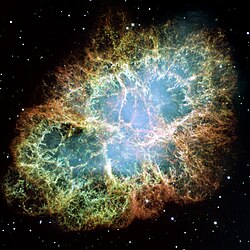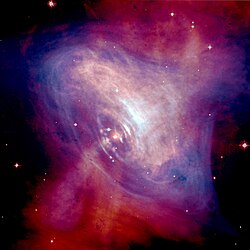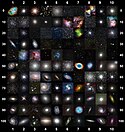Crab Nebula, as Seen by Herschel and Hubble
A wispy and filamentary cloud of gas and dust, the Crab nebula is the remnant of a supernova explosion that was observed by Chinese astronomers in the year 1054.
The image combines Hubble's view of the nebula at visible wavelengths, obtained using three different filters sensitive to the emission from oxygen and sulphur ions and is shown here in blue. Herschel's far-infrared image reveals the emission from dust in the nebula and is shown here in red.
While studying the dust content of the Crab nebula with Herschel, a team of astronomers have detected emission lines from argon hydride, a molecular ion containing the noble gas argon. This is the first detection of a noble-gas based compound in space.
The Herschel image is based on data taken with the Photoconductor Array Camera and Spectrometer (PACS) instrument at a wavelength of 70 microns; the Hubble image is based on archival data from the Wide Field and Planetary Camera 2 (WFPC2).Relevante Bilder
Relevante Artikel
KrebsnebelDer Krebsnebel im Sternbild Stier ist der Überrest der im Jahr 1054 beobachteten Supernova, in dem sich ein Pulsarwind-Nebel gebildet hat. Er befindet sich im Perseus-Arm der Milchstraße und ist etwa 1900 Parsec von der Erde entfernt. .. weiterlesen










